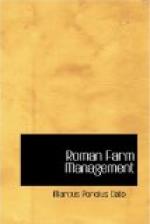Scrofa resumed: “Take care to avoid having the steading face the direction from which disagreeable winds blow, yet you should not build in a hollow. High ground is the best location for a steading: for by ventilation all noxious gases are dissipated, and the steading is healthier if exposed to the sun all day: with the further advantage that any insects which may be bred in or brought upon the premises are either blown away or quickly perish where there is no damp. Sudden rains and overflowed streams are dangerous to those who have their steadings in low or hollow places, and they are more at the hazard of the ruthless hand of the robber because he is able to take advantage of those who are unprepared. Against either of these risks the higher places are safer.”
d. Arrangement
XIII. In arranging the steading, see that the cattle are put where they will be warm in winter. Such crops as wine and oil should be housed below ground in cellars, or rather in jars placed in such cellars, while dry crops like beans, and hay, are best stored on high board floors. A rest room should be provided for the comfort of the hands where they can gather after the day’s work or for protection from cold or heat and there recruit themselves in quiet. The room of the overseer should be near the entrance to the farm house so that he may know who comes in and who goes out during the night, and what they bring in or out, especially if there is no gate-keeper. The kitchen also should be near the overseer’s room because there in winter is great activity before daylight when food is being prepared and eaten. Good sized sheds should be built in the barn yard for the wagons and other implements which might be damaged by the rain. For while they may be kept safe from the thief within the gates, yet if they are exposed to the weather they will be lost nevertheless. It is better to have two barn yards for a large farm. The inner court should contain a cistern like a little fish pond into which the drainage from the eaves may collect: as here the cattle and swine and geese can drink and bathe in summer when they are driven in from work or pasture. In the outer court there should be another pond where you can handle lupines and such other things as must be soaked in water. This exterior court yard should be strewn thick with straw and chaff, which, by being trampled under the feet of the cattle, becomes the handmaid of the farm by reason of the service it renders when it is hauled out. Every farm should have two manure pits, or one divided into two parts; into one division should be put the new manure from the barn, in the other the old manure which is ready for use on the farm: for new manure is not as good as that which is well rotted.[69] The manure pit is more serviceable when its sides and top are protected from the sun by leaves and branches, for the sun draws out from the manure those elements which the land requires; for this reason




